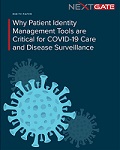Health Information Exchange (HIE) is happening every minute of every day. Your personal health information is moving and being viewed to improve the quality of your healthcare and lower the costs. The job will not be complete until all health records are digital and interoperable. Here’s what’s happening to make that reality.
Listen
On The Incrementalist, host Dr. Nick van Terheyden aka Dr. Nick’s guest is the Founder & Chief Health Innovator of Rimidi, Lucienne Ide, MD, PhD discussing integrating patient data. How cloud based patient generated data is integrated into the broader health system. Interoperability and capitalizing on FHIR, and the HEAL initiative launched with CTA and Connected Health.
News and Noted
CynergisTek Launches New Service to Better Manage Risk of APIs and Navigate New Interoperability Rules
CynergisTek, Inc. (@cynergistek) announced the launch of their API Sentry service, developed specifically for healthcare organizations to manage the risks associated with the use of APIs within their environment. CynergisTek’s API Sentry service is powered by APIsec.ai, which leverages unique technology to facilitate ongoing testing and identifies security vulnerabilities, business logic flaws, and access control issues that can lead to a loss of sensitive data.
eHealth Technologies and SYNCRONYS Partner to Provide Image Exchange for New Mexico
SYNCRONYS (formerly known as New Mexico Health Information Collaborative), New Mexico’s designated Health Information Exchange (HIE), has partnered with eHealth Technologies (@eHealthTec) to give care providers in its community “one-click” access to medical images for patients from across the state.
Life Image Network Connector (LINC) Launches to Help Healthcare Entrepreneurs, Imaging Centers, Innovators and Physician Groups Improve Imaging and Clinical Data Exchange
Life Image (@lifeimageinc), the world’s largest medical evidence network for clinical and imaging data, announced the availability of Life Image Network Connector (LINC). It is the company’s latest interoperability solution, developed due to demand from smaller healthcare organizations to digitally exchange medical images and other health data with the company’s market-leading network of large Academic Medical Centers, specialty hospitals, research organizations, and health systems. The need to share advanced patient data such as imaging has been exposed as a systemwide weakness by COVID-19 and new federal information blocking and patient-access rules that are set to go into effect next year, which must be addressed by all providers.
Life Image Veterans Exchange (LIVE) is Launched to Enable Imaging and Data Interoperability Between Veterans Health Administration Hospitals and Community Care Network Providers
Life Image (@lifeimageinc) also announced the availability of the Life Image Veterans Exchange (LIVE), which was specifically designed to meet the stringent security and regulatory protocols that are required to handle sensitive imaging and medical data for veterans who are seeking care at Veterans Health Administration’s (VHA) community care network (CCN) clinics and hospitals.
DSS, Inc. Partners with Diasyst to Empower Clinicians to Better Manage Chronically Ill Patients at the VA
Document Storage Systems, Inc. (DSS, Inc.) (@DSSHealthIT), a provider of health information technology (HIT) solutions for federal, private and public healthcare organizations, announced a new partnership effort with Diasyst, a provider of the best of breed technologies to empower healthcare organizations to monitor and manage chronically ill patients.
CAQH Announces Development of National Directory of FHIR Endpoints
CAQH (@CAQH) announced the development of a centralized directory of validated payer FHIR endpoints and third-party applications. This solution will simplify how healthcare organizations and app developers connect with each other to help consumers access and transfer their healthcare information. The directory, developed with support from the technology company Edifecs, will help payers meet new Centers for Medicare and Medicaid Services (CMS) interoperability regulations that become effective in 2021 and 2022.
To Read & Watch
Interoperability: The Current State of the Future – By Drew Ivan, Chief Product and Strategy Officer at Lyniate (@lyniate) – Science fiction writer William Gibson once said, “The future is already here. It’s just not evenly distributed.” We could say the same about interoperability. In my recent session The Future of Interoperability, given at Lyniate’s CONNECT/20 customer conference, I explained how despite complaints that we haven’t achieved interoperability, we actually have met multiple goals. Trouble is, the goalposts keep moving. In other words, the future of interoperability is already here. It’s just not evenly distributed.
Achieving Value With Interoperability – By Justin Gernot, Vice President, Healthbox (@Healthbox) – Digital transformation is transitioning from a nice-to-have to a mission-critical element of any healthcare provider’s strategy. The HIMSS Digital Health Indicator (DHI) objectively measures a provider organization’s progress toward a digital health ecosystem that enables consumers to manage their health and wellness using digital tools—supported by connectivity with clinicians and provider teams—in a secure and private environment whenever and wherever care is needed. The DHI is the only comprehensive tool to assess and advise health system leaders on how to achieve outcomes using digital health, not just to use technologies or achieve other more specific measures. This blog series dives into each of the four dimensions of the DHI: governance and workforce, interoperability, predictive analytics, and person-enabled healthcare.
Events
HL7
Java developers looking to get started or improve their skills developing FHIR-based solutions — this class is for you. HAPI on #FHIR runs December 2 & 3 from 12-2 PM EST. Register at https://t.co/hssMLAHeee#HL7 #HAPIFHIR #interoperability #healthIT pic.twitter.com/lGIK6OlN7P
— HL7 International (@HL7) November 19, 2020
AZHealthCurrent
Did you miss the #Summit2020 or want to watch again? Archive presentations are available until November 30. Learn More. #HIE, #AZHIE https://t.co/2UMyXlYhzV pic.twitter.com/kPNJYW6fBb
— AZHealthCurrent (@AZHealthCurrent) November 19, 2020
Organizations
PATIENT ID NOW
Patient ID Now is a coalition of healthcare organizations representing a wide range of healthcare stakeholders committed to advancing through legislation and regulations a nationwide strategy to address patient identification. Read more about the coalition.
- Patient Matching: An Essential Tool in the Era of COVID-19
Free Recording
The COVID-19 pandemic has highlighted the importance of ensuring patients are accurately matched to their medical records, yet the problem of patient misidentification persists, endangering patient safety, and the public health response. Listen to the newly formed Patient ID Now Coalition during a virtual hill briefing with health leaders on July 7. They dive into the implications of patient matching and identification during the pandemic.
Patient ID Now Coalition Pleased Congress is Addressing Patient Misidentification
Patient ID Now, a coalition of leading healthcare organizations, including the American College of Surgeons, the American Health Information Management Association (AHIMA), the College of Healthcare Information Management Executives (CHIME), Healthcare Information and Management Systems Society (HIMSS), Intermountain Healthcare and Premier Healthcare Alliance, is pleased that the U.S. House of Representatives voted to remove the longstanding ban in its Labor, Health and Human Services, Education, and Related Agencies appropriations bill that stifles innovation around patient identification.
The Strategic Health Information Exchange Collaborative
SHIEC (@SHIEClive) is the National Trade Association for Health Information Exchange Organizations. It is routine for important data about patients’ ongoing care to reside in multiple unconnected organizations. SHIEC member HIEs use information technology and trusted relationships in their service areas to enable secure, authorized exchange of patient information among disparate providers. By providing enhanced access to all available and relevant patient data SHIEC HIE members aim to improve the quality, coordination, and cost-effectiveness of health care provided in their communities. Read their news feed.
The Sequoia Project
The Sequoia Project (@SequoiaProject) was chartered to advance the implementation of secure, interoperable nationwide health information exchange. The ONC transitioned management of its eHealth Exchange to The Sequoia Project for maintenance. Since 2012, the Exchange has grown to become the largest health information exchange network in the country.
The Sequoia Project Publish Person Matching Case Study with 99.5% Accuracy
The Sequoia Project, a non-profit and trusted advocate for nationwide health information exchange, patient identity management experts collaborated with the Blue Cross Blue Shield Association (BCBSA) to apply A Framework for Cross-Organizational Patient Identity Management for the payer community and develop person matching strategies. The Sequoia Project published Person Matching for Greater Interoperability: A Case Study for Payers which demonstrates high matching accuracy rates, and provides actionable insights for improving person identity matching across the payer community, a critical component of successful health information exchange and interoperability.
The CommonWell
CommonWell Health Alliance (@CommonWell) is devoted to the simple vision that health data should be available to individuals and providers regardless of where care occurs. Additionally, provider access to this data must be built-in health IT at a reasonable cost for use by a broad range of health care providers and the people they serve.
Last week, we hosted our first virtual Fall Summit! Get the scoop from @paul_wilder in our newest blog. https://t.co/MrJDUljb44 #CWFallSummit #InteropDoneRight pic.twitter.com/7O6GuDU5Cb
— CommonWell (@CommonWell) November 12, 2020
Slow COVID-19: CommonWell Member Resources & Initiatives
Since inception, CommonWell members have been innovators and game changers in the health IT space. Today is no different. In this time of uncertainty and stress to both our health system and our personal wellbeing, it is not surprising that their members once again are stepping up to the challenge to solve some of our world’s biggest challenges. Through their website, they will continue to share and update what their members are doing in the fight to slow COVID-19, provide necessary care coordination resources, and ultimately, help save lives.
DirectTrust
A pioneer in offering technical trust and confidence in the secure exchange of health information, DirectTrust (@DirectTrustorg) is committed to collaboration for advancing secure communication. As a non-profit trade alliance, DirectTrust operates not only as a membership organization, but also as an ANSI-accredited standards body, a trust framework supported by policy, and an accreditor for reliable and trusted exchange across the DirectTrust network. Read their News and Events.
Resources
 Why Patient Identity Management Tools are Critical for COVID-19 Care and Disease Surveillance
Why Patient Identity Management Tools are Critical for COVID-19 Care and Disease Surveillance
Is your organization struggling to achieve an integrated data environment amid COVID-19? Does fragmented patient information slow down your response efforts? Effective case management and reporting requires ongoing support and creative solutions for healthcare’s most fundamental problems—including oft-overlooked patient identity matching and health information exchange.
Download this eBook by NextGate to learn how to:
- Bridge the infrastructure gaps that impact COVID-19 responses
- Overcome demographic data challenges needed create a longitudinal
 Consensus: The Chase for Interoperability
Consensus: The Chase for Interoperability
In its continued campaign to bring about data interoperability across the healthcare industry by 2024, the HHS’s Office of the National Coordinator (ONC) and Centers for Medicare & Medicaid Services (CMS) jointly released a set of new rules in 2019 to further promote the seamless exchange of protected health information (PHI). Despite increasing attempts to facilitate interoperability through regulations, the challenges lie elsewhere in creating seamless data exchange among a patient’s physician, hospital, labs, pharmacy, and others along the continuum of care.
Download this paper by eFax Corporate to learn more about the fastest, most cost-effective way for your organization to access and share patient data through one interoperable platform.
eHealth Initiative Resource Center
Interoperability Files – Check out the new white paper resource in the eHealth Initiative’s (@eHealthDC) Resource Center: FHIR FAQs
ONC Interoperability Pledge
Companies that provide 90 percent of electronic health records used by hospitals nationwide as well as the top five largest health care systems in the country have agreed to implement three core commitments: Consumer Access, No Blocking/Ensuring Transparency, and Standards. The ONC (@ONC_HealthIT) wants vendors to sign a pledge. Is your vendor pledging? Find out who is on the list.
